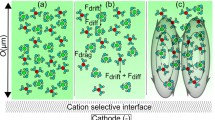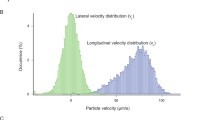Abstract
Electrokinetic effects play an important role in microfluidics and nanofluidics. Although the related phenomena are often utilized to control fluid flow and sample transport in lab-on-a-chip devices, their dependency on the surface charges on the channel walls often remain enigmatic. This is mainly due to the lack of adequate experimental methods to analyse the electrical charging of solid/liquid interfaces of interest. To address this need, an experimental set-up—designated as microslit electrokinetic set-up (MES)—has been recently developed and applied for the investigation of charge formation processes at planar solid/liquid interfaces. The device permits to perform streaming potential and streaming current measurements across a rectangular streaming channel formed by two parallel sample carriers (20×10×3 mm3) at variable distance allowing for the determination of the surface conductivity. Utilizing the MES, charge characteristics can be determined for a wide variety of materials prepared as thin films on top of planar glass substrates. Streaming potential and streaming current data permit to investigate the mechanisms of charge formation while surface conductivity data provide information about mobile charge carriers located in different zones at the interface. The applicability of this advanced experimental approach is demonstrated with examples obtained for surfaces with different levels of complexity:
-
1.
Preferential ion adsorption onto unpolar fluoropolymer (Teflon® AF) films was characterized in simple electrolyte solutions; the results were quantitatively evaluated with respect to interfacial ion concentrations.
-
2.
Interrelation of charge density and conformation of grafted poly(L-glutamic acid layers) were unravelled from the determination of pH-depended variations of surface conductivity and layer thickness.
-
3.
The impact of spatial confinements of surface functional groups on their acid–base behaviour was studied with self-assembled monomolecular films of alkanethiols chemisorbed on gold.
-
4.
Charging of and ion mobility within poly(acrylic acid) (PAA) brushes prepared by a Langmuir–Blodgett technique were analysed at varied pH and ionic strength.
-
5.
Interfacial modes of adsorbed proteins were distinguished at two polymer surfaces with varied hydrophobicity/charge density.










Similar content being viewed by others
References
Aoki K, Kakiuchi T (1999) pKa of an ω-carboxylalkanethiol self-assembled monolayer by interaction model. J Electroanal Chem 478:101–107
Baerga-Ortiz A, Rezaie AR, Komives EA (2000) Electrostatic dependence of the thrombin–thrombomodulin interaction. J Mol Biol 296:651–658
Bikerman JJ (1935) Die Oberflächenleitfähigkeit und ihre Bedeutung. Kolloid Z 72:100–108
Bismarck A, Kumru ME, Springer J (1999) Characterization of several polymer surfaces by streaming potential and wetting measurements: some reflections on acid–base interactions. J Colloid Interface Sci 217:377–387
Brew SA, Ingham KC (1994) Purification of human plasma fibronectin. J Tissue Cult Methods 16:197–199
Brinkman HC (1947) A calculation of the viscous force exerted by a flowing fluid on a dense swarm of particles. Appl Sci Res A1:27–34
Creager SE, Clarke JE (1994) Contact-angle titrations of mixed omega—mercaptoalkanoic acid/alkanethiol monolayers on gold. Reactive versus nonreactive spreading, and chain length effects on surface pKa values. Langmuir 10:3675–3683
Currie EPK, Leermakers FAM, Cohen Stuart MA, Fleer GJ (1999a) Grafted adsorbing polymers: scaling behavior and phase transitions. Macromolecules 32:487–498
Currie EPK, Sieval AB, Avena M, Zuilhof H, Sudhölter EJR, Cohen Stuart MA (1999b) Weak polyacid brushes: preparation by LB deposition and optically detected titrations. Langmuir 15:7116–7118
Currie EPK, van der Gucht J, Borisov OV, Cohen Stuart MA (1999c) Stuffed brushes: theory and experiment. Pure Appl Chem 71:1227–1241
Currie EPK, Wagemaker M, Cohen Stuart MA, van Well AA (1999d) Structure of monodisperse and bimodal brushes. Macromolecules 32:9041–9050
Currie EPK, Sieval AB, Fleer GJ, Cohen Stuart MA (2000) Polyacrylic acid brushes: surface pressure and salt-induced swelling. Langmuir 16:8324–8333
Dukhin SS, Derjaguin BV (1974) Electrokinetic phenomena. In: Matijevic E (ed) Surface and colloid science, vol 7. Wiley, New York
Dukhin SS, Zimmermann R, Werner C (2004) Intrinsic charge and Donnan potentials of grafted polyelectrolyte layers determined by surface conductivity data. J Colloid Interface Sci 274:309–318
Dukhin SS, Zimmermann R, Werner C (2005) Electrokinetic phenomena at grafted polyelectrolyte layers. J Collid Interface Sci 286:761–773
Duval JFL, van Leeuwen HP (2004) Electrokinetics of diffuse soft interfaces. 1. Limit of low potentials. Langmuir 20:10324–10336
Erickson D, Li D (2002) Microchannel flow with patchwise and periodic surface heterogeneity. Langmuir 18:8949–8959
de Feijter JA, Benjamins J, Veer FA (1978) Ellipsometry as a tool to study the adsorption behavior of synthetic and biopolymers at the air–water interface. Biopolym 17:1759–1772
Fodor SPA, Rava RP, Huang XC, Pease AC, Holmes CP, Adams CL (1993) Multiplexed biochemical assays with biological chips. Nature 364:555–556
Frisbie CD, Rozsnyai LF, Noy A, Wrighton MS, Lieber CM (1994) Functional group imaging by chemical force microscopy. Science 265:2071–2074
Garbassi F, Morra M, Occhiello E (1996) Polymer surfaces: from physics to technology. Wiley, Chichester
Grundke K, Jacobasch HJ, Simon F, Schneider S (1995) Physico-chemical properties of surface-modified polymers. J Adhes Sci Technol 9:327–350
Healy TW, White LR (1978) Ionizable surface group models of aqueous interfaces. Adv Colloid Interface Sci 9:303–345
Hu K, Bard AJ (1997) Use of atomic force microscopy for the study of surface acid–base properties of carboxylic acid-terminated self-assembled monolayers. Langmuir 13:5114–5119
Hunter RJ (1981) Zeta potential in colloid science: principles and applications. Academic, London
Jacobasch HJ (1984) Oberflächenchemie faserbildender Polymerer. Akademie Verlag, Berlin
Jacobasch HJ, Schurz J (1988) Characterization of polymer surfaces by means of electrokinetic measurements. Progr Colloid Polym Sci 77:40–48
Jeon SI, Andrade JD (1991) Protein–surface interactions in the presence of polyethylene oxide. J Colloid Interface Sci 142:159–166
Johnson EM, Berk DA, Jain RK, Deen WM (1996) Hindered diffusion in agarose gels: test of effective medium model. Biophys J 70:1017–1023
Kane V, Mulvaney P (1998) Double-layer interactions between self-assembled monolayers of mercaptoundecanoic acid on gold surfaces. Langmuir 14:3303–3311
Kokkoli E, Zukoski CF (2000) Surface forces between hydrophilic self-assembled monolayers in aqueous electrolytes. Langmuir 16:6029–6036
Körber H, Werner C, Jacobasch HJ (1999) Micro-slit cell. Patent WO 99/30141
Liu X, Farmerie W, Schuster S, Tan W (2000) Molecular beacons for DNA biosensors with micrometer to submicrometer dimensions. Anal Biochem 283:56–63
Löbbus M, van Leeuwen HP, Lyklema J (2000) Streaming potentials and conductivities of latex plugs. Influence of the valency of the counterion. Colloids Surf A 61:103–113
Lyklema J (1995) Fundamentals of colloid and interface science, vol 2, solid–liquid interfaces, Academic, London
Lyklema J, Rovillard S, Coninck JD (1998) Electrokinetics: the properties of the stagnant layer. Langmuir 14:5659–5663
McDiarmid R, Doty P (1966) The spectrophotometric titration of polyacrylic, poly-L-aspartic, and poly-L-glutamic acids. J Phys Chem 70:2620–2627
Minor M, van der Linde AJ, Lyklema J (1998) Streaming potentials and conductivities of latex plugs in indifferent electrolytes. J Colloid Interface Sci 203:177–188
Nagasawa M, Holtzer A (1964) The helix–coil transition in solutions of polyglutamic acid. J Am Chem Soc 86:538–543
Nitzsche R, Simon F (1997) Bestimmung des Zetapotentials aus Messungen der elektrophoretischen Mobilität. Technisches Messen 64:106–113
Ohshima H (1995) Electrophoretic mobility of soft particles. Colloids Surf A 103:249–255
Osaki T, Werner C (2003) Ionization characteristics and structural transitions of alternating maleic acid copolymer films. Langmuir 19:5787–5793
Paoletti S, Cesaro A, Samper CA, Benegas JC (1989) Conformational transitions of poly(α-L-glutamic acid). A polyelectrolytic approach. Biophys Chem 34:301–309
Phillips RJ (2000) A hydrodynamic model for hindered diffusion of proteins and micelles in hydrogels. Biophys J 79:3350–3354
Pompe T, Zschoche S, Salchert K, Herold N, Gouzy MF, Sperling C, Werner C (2003) Maleic anhydride copolymers—a versatile platform for molecular biosurface engineering. Biomacromolecules 4:1072–1079
Pompe T, Markowski M, Werner C (2004) Modulated fibronectin anchorage at polymer substrates controls angiogenesis. Tissue Eng 10:841–848
Pompe T, Renner L, Grimmer M, Herold N, Werner C (2005) Functional films of maleic anhydride copolymers under physiological conditions. Macromol Biosci 5:890–895
Pompe T, Renner L, Werner C (2005) Nanoscale features of fibronectin fibrillogenesis depend on protein–substrate interaction and cytoskeleton structure. Biophys J 88:527–534
van der Put AG (1980) Electrokinetic investigations on the system polystyrene/aqueous electrolyte solution. PhD thesis, Wageningen Agricultural University
Renner L, Pompe T, Salchert K, Werner C (2004) Dynamic alterations of fibronectin layers on copolymer substrates with graded physicochemical characteristics. Langmuir 20:2928–2933
Renner L, Pompe T, Salchert K, Werner C (2005) Fibronectin displacement at polymer surfaces. Langmuir 21:4571–4577
Riepl M, Mirsky VM, Novotny I, Tvarozek V, Rehacek V, Wolfbeis OS (1999) Optimization of capacitive affinity sensors: drift suppression and signal amplification. Anal Chim Acta 392:77–84
Schmitt FJ (2002) Wechselwirkungen und Adhäsion von Polymer-Grenzflächen. Habilitation thesis, Dresden University of Technology
Schweiss R, Pleul D, Simon F, Janke A, Welzel PB, Voit B, Knoll W, Werner C (2004) Electrokinetic potentials of binary self-assembled monolayers on gold: acid–base reactions and double layer struture. J Phys Chem B 108:2910–2917
Schweiss R, Welzel P, Knoll W, Werner C (2005) Assembly modulates dissociation: electrokinetic experiments reveal peculiarities of the charge formation at monolayer films. Chem Comm 256–258
Stroock AD, Weck M, Chiu DT, Huck WTS, Kenis PJA, Ismagilov RF, Whitesides GM (2000) Patterning electroosmotic flow with patterned surface charge. Phys Rev Lett 84:3314–3317
Toony NM, Mosesson MW, Amrani DL, Hainfeld JF, Wall JS (1983) Solutions and surface effects on plasma fibronectin structure. J Cell Biol 97:1686–1692
Uyama Y, Kato K, Ikada Y (1998) Surface modification of polymers by grafting. Adv Polym Sci 137:1–39
van der Vegte EW, Hadziioannou G (1997) Acid–base properties and the chemical imaging of surface-bound functional groups studied with scanning force microscopy. J Phys Chem B 101:9563–9569
Vörös J (2004) The density and refractive index of adsorbing protein layers. Biophys J 87:553–561
van Wagenen RA, Andrade JD (1980) Flat plate streaming potential investigations: hydrodynamics and electrokinetic equivalency. J Colloid Interface Sci 76:305–314
Werner C, Körber H, Zimmermann R, Dukhin SS, Jacobasch HJ (1998) Extended electrokinetic characterization of flat solid surfaces. J Colloid Interf Sci 208:329–346
Werner C, König U, Augsburg A, Arnhold C, Körber H, Zimmermann R, Jacobasch HJ (1999) Electrokinetic surface characterization of biomedical polymers—a survey. Colloids Surf A 159:519–529
Wilson K, Stuart SJ, Garcia AJ, Latour RA (2004) A molecular modeling study of the effect of surface chemistry on the adsorption of a fibronectin fragment spanning the 7–10th type III repeats. J Biomed Mater Res 69A:686–698
Yezek LP (2005) Bulk conductivity of soft surface layers: experimental measurement and electrokinetic implications. Langmuir 21:10054–10060
Zimmermann R, Dukhin SS, Werner C (2001) Electrokinetic measurements reveal interfacial charge at polymer films caused by simple electrolyte ions. J Phys Chem B 105:8544–8549
Zimmermann R, Birkert O, Gauglitz G, Werner C (2003) Electrosurface Phenomena at Polymer Films for Biosensor Applications. Chem Phys Chem 4:509–514
Author information
Authors and Affiliations
Corresponding author
Rights and permissions
About this article
Cite this article
Zimmermann, R., Osaki, T., Schweiß, R. et al. Electrokinetic microslit experiments to analyse the charge formation at solid/liquid interfaces. Microfluid Nanofluid 2, 367–379 (2006). https://doi.org/10.1007/s10404-006-0087-6
Received:
Accepted:
Published:
Issue Date:
DOI: https://doi.org/10.1007/s10404-006-0087-6




